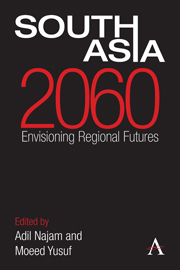Book contents
- Frontmatter
- Contents
- Acknowledgments
- List of Abbreviations
- Introduction: Imagining South Asian Futures
- Section I South Asia as a Region
- Section II State Relations
- Chapter 6 The Future of Democracy
- Chapter 7 Conflict and Reconciliation: Three Scenarios
- Chapter 8 Religion and State Formation
- Chapter 9 Will South Asia Still Be Terrorism's Center of Gravity?
- Chapter 10 Speculations on Nuclear South Asia
- Chapter 11 Nuclear Risk: Overstated or Underrated?
- Chapter 12 The Shadow of the India–Pakistan Stalemate
- Chapter 13 Regional Integration
- Chapter 14 The Future of Integration
- Chapter 15 The Giant Neighbor: Why is China Important?
- Section III Development
- Section IV Human Well-Being
- About the Authors
- Bibliography
- Index
Chapter 7 - Conflict and Reconciliation: Three Scenarios
from Section II - State Relations
Published online by Cambridge University Press: 05 September 2013
- Frontmatter
- Contents
- Acknowledgments
- List of Abbreviations
- Introduction: Imagining South Asian Futures
- Section I South Asia as a Region
- Section II State Relations
- Chapter 6 The Future of Democracy
- Chapter 7 Conflict and Reconciliation: Three Scenarios
- Chapter 8 Religion and State Formation
- Chapter 9 Will South Asia Still Be Terrorism's Center of Gravity?
- Chapter 10 Speculations on Nuclear South Asia
- Chapter 11 Nuclear Risk: Overstated or Underrated?
- Chapter 12 The Shadow of the India–Pakistan Stalemate
- Chapter 13 Regional Integration
- Chapter 14 The Future of Integration
- Chapter 15 The Giant Neighbor: Why is China Important?
- Section III Development
- Section IV Human Well-Being
- About the Authors
- Bibliography
- Index
Summary
There are few regions in the international system whose future seems to have been as difficult to predict as South Asia. Almost all the writings that looked at South Asia, say 50 years ago, were way off the mark. That is true even of the assessments of individual countries. There are several reasons for these inaccurate predictions. Forecasting the future, as we know, is a small industry in the West. Thinking long term is, of course, important, as is identifying the main drivers of change. But most Western analyses of South Asia have suffered from a clear ethnocentric bias. Analysts have predictably, if unfortunately, sought to capsule the region into a preconceived Western mould. “Occidental” attempts at forcing an Eastern intellectual puzzle into preconceived categories have just not worked.
Take the case of the India–Pakistan relationship, arguably the single most critical factor for the region. The conflict between India and Pakistan is easy to describe, but painfully difficult to understand. We have witnessed how apparently well-thought-out prescriptions have failed, even as policy analysts have invented catchy titles for the troubled relationship. “Enduring rivalry,” “sustained conflict,” and “ugly stability,” are terms that form the standard lexicon of South Asia watchers particularly in the United States. But this really is reductio ad absurdum as is evident to almost anyone with more than just a passing sense of history of the region.
- Type
- Chapter
- Information
- South Asia 2060Envisioning Regional Futures, pp. 61 - 67Publisher: Anthem PressPrint publication year: 2013



